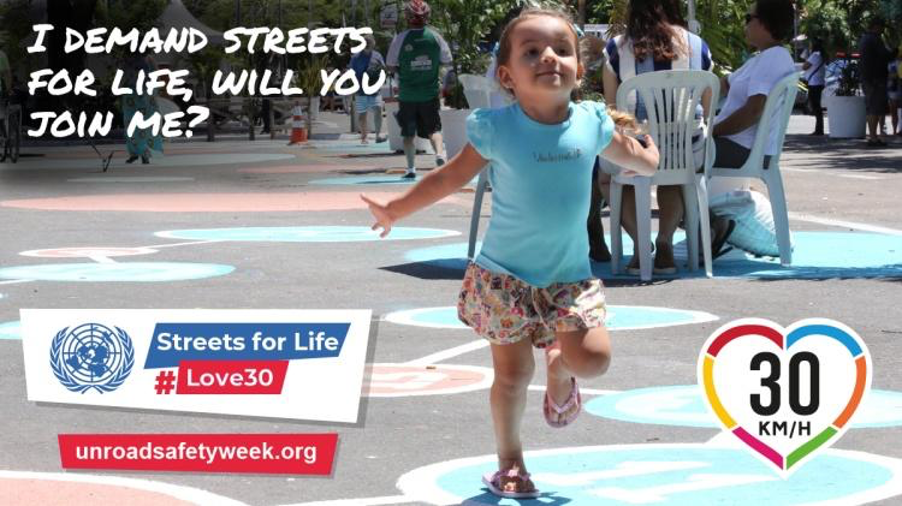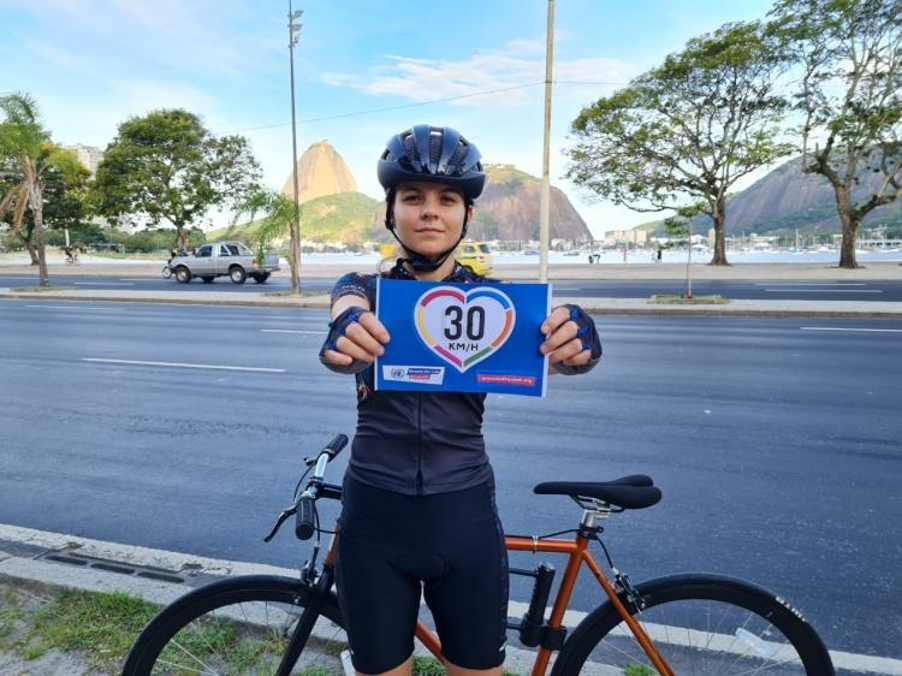Author: Cities4Children
According to the World Health Organization (WHO), road traffic crashes are the leading cause of death for children and young people aged 5 to 29 years. One of the most effective strategies to reduce road traffic crashes is to reduce speed limits to 30 km per hour or lower in areas where vulnerable road users like pedestrians and cyclists can move freely in cities. The Streets for Life and #Love30 campaign was the focus of the 6th UN Global Road Safety Week (UNGRSW).
As we approach the 7th UNGRSW, here’s another look at why it is so important to continue to support global efforts to reduce speeds to 30 km/h.

Streets for Life #Love30 campaign in the City of Fortaleza © Marcos Moura, UNGRSW, 2021
Streets for life: Why #Love30
A 30 km/h or 20 mph speed limit saves lives and helps make streets healthy, green, and liveable. Reducing speed limits to 30 km/h and lower can encourage healthy behaviours like walking and cycling, transforming car-dominated neighbourhoods to more people-friendly spaces with reduced noise levels. Lower speed limits also protect all road users, especially vulnerable road users like pedestrians, cyclists, children, senior citizens, and people with disabilities.
Improving road safety is fundamental to achieving several Sustainable Development Goals and targets, specifically those related to health security, sustainable cities, poverty reduction, and reducing inequalities among and within countries around the world.
The campaign calls on decision-makers to act for low-speed streets worldwide and limit traffic speeds to 30 km/h so people can walk, live, and play safely. Policies that promote safer streets also promote gender equality and inclusive mobility and enable safe, sustainable, and inclusive cities.
Facts and myths around 30 km/h
FACT#1 Evidence from around the world shows that low-speed streets with speed limits of 30km/h or lower reduce the risk of serious injuries and ultimately help save lives. A study from London found that lower speed limits (in this case, 20 mph zones) were associated with a 42% reduction in road casualties. In Bristol, introducing 20 mph limits was associated with a 63% reduction in fatal injuries between 2008 and 2016.

Love30 saves lives © Bruna Mesquita, Brazil, UNGRSW 2021
Fact #2: With above 30 km/h impact speeds, pedestrians are at a higher risk of death. This risk is even greater for the young and elderly. At the same distance a 30 km/h car can stop, a 50 km/h car will have difficulty even slowing down. Higher speeds narrow motorists’ peripheral vision and impact their reaction times.
Popular myths include:
- Lower speed limits increase journey times
- 30 km/h speed limits are highly unpopular
- 30 km/h is only available for a few countries
- 30 km/h limits are anti-motorist
This WHO report presents evidence to tackle these myths. It shows that:
- In city streets, the time saved when driving at 50 km/h as compared to 30 km/h is minimal
- A majority of people agree that 30 km/h is the correct speed limit for residential roads
- 30 km/h zones have been successfully established in neighbourhoods in Africa, North America, Asia, Europe, Latin America, and Australasia
- Low-speed streets can make life better for motorists
How to #Love30
According to this report published by the WHO on managing speed, there are five ways to enable 30km/hr and lower speeds:
- Building or modifying roads to include traffic calming features, such as speed bumps, footpaths, signage, and bollards. Other examples include shared streets like woonerfs in the Netherlands and shared zones like Superblocks in Barcelona.
- Establishing speed limits appropriate to the function of each road, such as 30 km/hr or lower speeds on roads with possible conflicts between cars and pedestrians, cyclists, or other vulnerable road users
- Enforcing speed limits through traffic cameras
- Installing in-vehicle technologies which alert drivers when they go above prescribed speed limits
- Raising awareness about the dangers of speeding through mass media campaigns to build public and political will for low-speed zones
Typically, neighbourhood-wide approaches work best. But where this is not possible or where uptake is slow, low-speed interventions should be prioritised around schools, parks and residential areas where children are among frequent road users. National and local websites with information to support the Love30 campaign can help support local and global campaigns.
Looking ahead
Actions like the Love30 campaign that make roads safer for children, young people and their caregivers also support active living, improve health and well-being, and make cities more liveable places. As safe and active mobility is central to improving cities for children and youth, we have published several blogs on the topic. These include blogs on the importance of open streets and walkability, the growth of school streets, how to design safe school zones, improving sustainable neighbourhood mobility through co-creation processes, using street theatre to raise public awareness and educate children on issues like road safety and climate change, and promoting cycling in cities. These blogs offer several actionable ideas for #RethinkMobility, the theme for this year’s UN Global Road Safety Week.

This blog is an adaptation of a news article published by Youth for Road Safety-YOURS titled 6th UN Road Safety Week launches with the strapline Streets for Life #Love30 campaign.
The Ideas4Action series aims to inspire with ideas that have worked in other cities and countries so that you too, can take action in your own city. Read more of our blogs here.
This work is licensed under a Creative Commons Attribution-NonCommercial-NoDerivatives 4.0 International License. When re-sharing this content please ensure accreditation by adding the following sentence: ‘This blog was first published by the Global Alliance – Cities4Children (www.cities4children.org/blog)’

